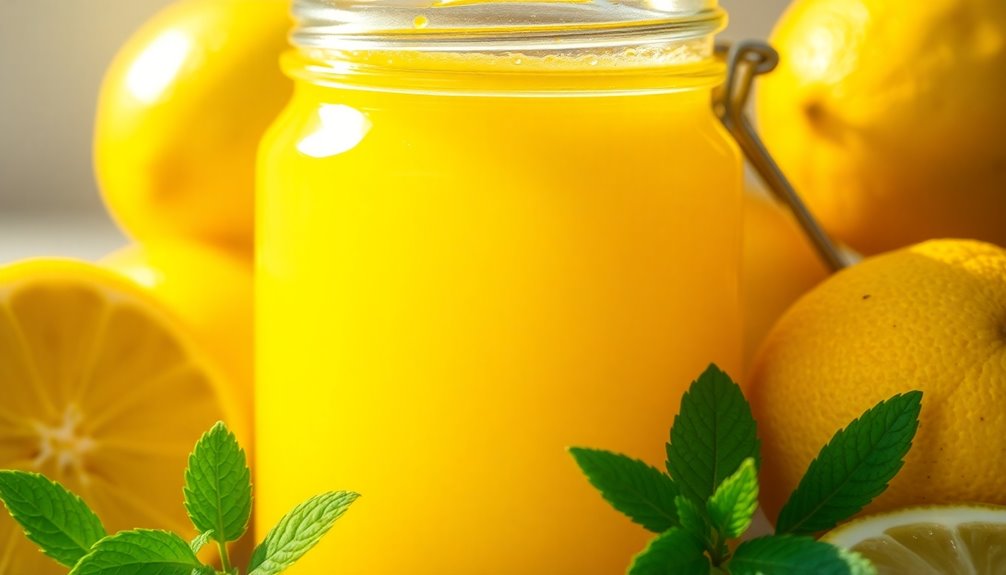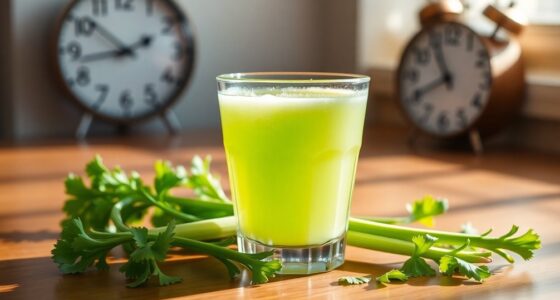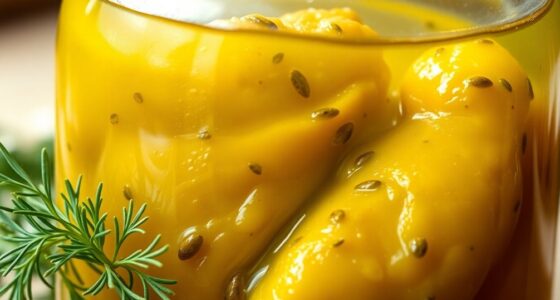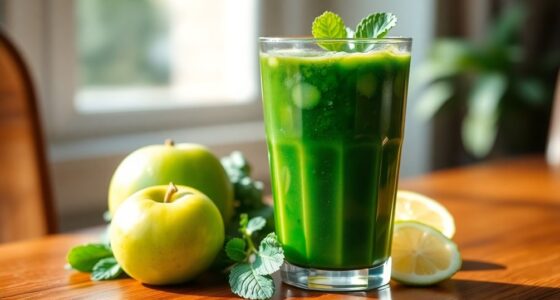Concentrated lemon juice can last up to six months after opening if you store it properly in the refrigerator. However, many users find it’s still good well beyond that timeframe. An unopened bottle can stay shelf-stable for 12 to 18 months. To keep it fresh, seal it tightly, avoid exposing it to air and light, and check for spoilage signs like off smells or changes in color. You might be surprised by other useful storage tips and methods! When considering how to store bottled lemon juice, remember that the type of bottle can also impact its longevity. Dark glass containers are preferable as they protect the juice from light, which can deteriorate its quality over time. Additionally, if you find yourself with leftover juice, consider pouring it into ice cube trays and freezing it for easy future use—this way, you can enjoy the fresh taste of lemon whenever you need it!
Key Takeaways
- Concentrated lemon juice lasts up to six months after opening when stored properly in the refrigerator.
- Unopened bottles can remain shelf-stable for 12 to 18 months due to pasteurization and preservatives.
- Signs of spoilage include changes in color, off smells, and unpleasant tastes; discard if any are present.
- Freezing the juice can extend its shelf life up to a year for convenient use.
- Always check the expiration date on unopened bottles to ensure safety before use.
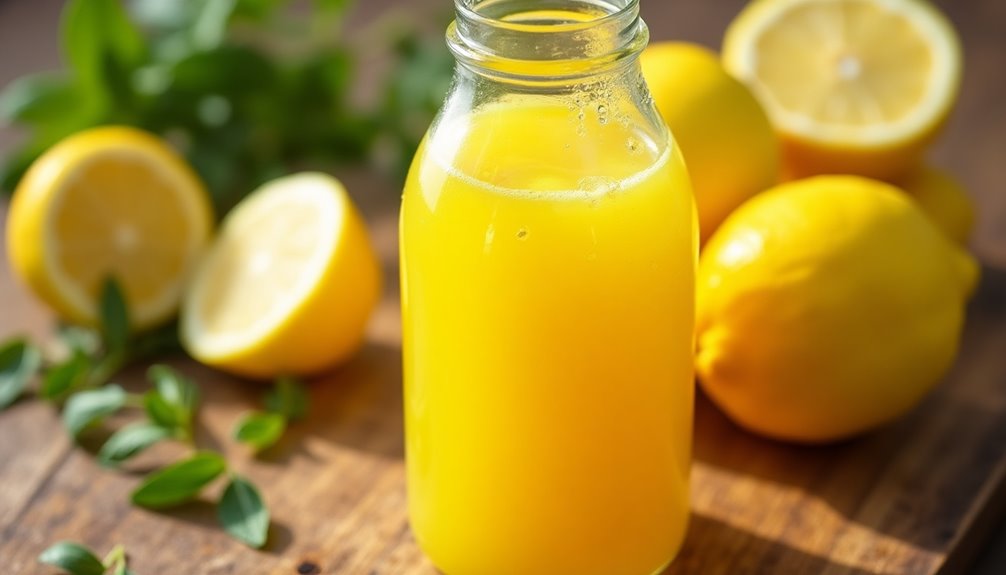
When you reach for that bottle of concentrated lemon juice, you might wonder how long it'll last once you open it. You'll be glad to know that, when properly stored in the refrigerator, concentrated lemon juice can last up to six months after opening. Some users even report using it successfully for longer periods. Unlike fresh lemon juice, the acidic nature of concentrated lemon juice helps inhibit bacterial growth, giving it a longer shelf life than other fruit juices.
Before you crack open that bottle, it's good to understand the shelf life of lemon juice in different states. Unopened bottles of concentrated lemon juice can remain shelf-stable for an impressive 12 to 18 months. This longevity is largely due to pasteurization and the preservatives added during processing. So, if you've got an unopened bottle in the pantry, feel free to check the expiration date; you may have some time before you need to use it.
Once you open the bottle, however, keep an eye on how you store it. Make sure to seal it tightly and place it in the refrigerator. Proper storage is key to maintaining its quality. After all, you don't want to waste any of that concentrated goodness, which is packed with vitamin C and great for adding flavor to drinks and dishes.
Now, it's also essential to be aware of the signs of spoilage. If you notice any changes in color, off smells, or unpleasant tastes, it's best to discard the juice. These changes indicate that the juice has gone bad and could potentially harm your health. Always trust your senses when it comes to food safety!
For those who want to extend the life of their concentrated lemon juice even further, consider freezing it. Pouring the juice into ice cube trays is a clever way to preserve its quality for up to a year. Once frozen, you can pop out the cubes and store them in a resealable bag or container. This method not only saves space but also allows you to use just the right amount whenever you need it.
Frequently Asked Questions
Does Concentrated Lemon Juice Go Bad?
Yes, concentrated lemon juice can go bad.
While its acidic nature helps prevent spoilage, it doesn't last forever. You should watch for changes in color, smell, or taste, which indicate it's time to toss it.
If you store it properly in the refrigerator, it can last quite a while, but always check for those spoilage signs.
Freezing it in ice cube trays is a great way to extend its life!
How Long Does Juice Concentrate Last in the Fridge?
Juice concentrate lasts in the fridge like a trusty old friend—always there when you need it.
Typically, after you open it, it should stay fresh for about three to six months if you store it properly. Just make sure it's tightly sealed to keep out any unwanted guests.
If you notice any weird smells, color changes, or mold, it's time to say goodbye and toss it out.
Enjoy your juice!
Is Concentrated Lemon Juice as Good as Fresh Lemon Juice?
When it comes to flavor, concentrated lemon juice isn't quite the same as fresh lemon juice.
While it offers convenience and a longer shelf life, you might find that fresh juice has a brighter, more vibrant taste.
That said, concentrated lemon juice can still work well in recipes, especially when you need consistency.
If you're looking for a quick substitute, it's a handy option, but fresh lemons do bring a unique freshness.
How to Store Concentrated Lemon Juice?
When it comes to storing concentrated lemon juice, you've got to keep it tight to avoid spoilage.
After opening, pop it in the fridge to extend its life. Unopened bottles can sit in a cool, dark pantry for months. Just make sure the cap's sealed well to keep air out.
If you want to stretch its freshness even further, freeze it in ice cube trays.
Always check for off smells or color changes before using!
Conclusion
In conclusion, concentrated lemon juice can last quite a while if you store it properly. Keep it sealed in the fridge, and it'll stay fresh for up to six months. Use it for cooking, mix it in drinks, or add a zesty kick to your recipes. So, whether you're sprucing up a dish or refreshing your beverage, remember that with the right storage, concentrated lemon juice can be a long-lasting, flavorful companion in your kitchen.
Cindy thoroughly researches juicing trends, techniques, and recipes to provide readers with practical advice and inspiration. Her writing style is accessible, engaging, and designed to make complex concepts easy to understand. Cindy’s dedication to promoting the advantages of juicing shines through her work, empowering readers to make positive changes in their lives through the simple act of juicing.

